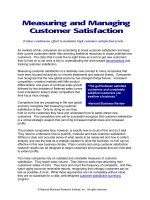Managing complex projects
Bạn đang xem bản rút gọn của tài liệu. Xem và tải ngay bản đầy đủ của tài liệu tại đây (3.69 MB, 329 trang )
Managing Complex Projects
A New Model
Managing Complex Projects
A New Model
K athleen B. Hass, PMP
8230 Leesburg Pike, Suite 800
Vienna, VA 22182
(703) 790-9595
Fax: (703) 790-1371
www.managementconcepts.com
Copyright © 2009 by Management Concepts, Inc.
All rights reserved. No part of this book may be reproduced or utilized in any form
or by any means, electronic or mechanical, including photocopying, recording, or by
an information storage and retrieval system, without permission in writing from the
publisher, except for brief quotations in review articles.
Printed in the United States of America
Library of Congress Cataloging-in-Publication Data
Hass, Kathleen B.
Managing complex projects : a new model / Kathleen B. Hass.
p. cm.
ISBN 978-1-56726-233-9
1. Project management. I. Title.
HD69.P75H3757 2009
658.4’04—dc22
10
9
8
7
6
5
4
2008027192
3
2
1
Praise for
Managing Complex Projects: A New Model
Kitty’s book is refreshing, insightful, and on-target. This is a serious look
at the challenges we face today in managing complexity on projects.
Though it is serious, it is a delight to read. Her research is impeccable,
her sources current, and her ideas original. Managers who listen to
her arguments and follow her advice will be at a great advantage in
dealing with the 21st century’s brave new world of complex project
management.
J. Davidson Frame, PhD, PMP, PMI Fellow
Academic Dean, University of Management and Technology
author of The New Project Management : Tools for an Age of Rapid Change,
Complexity, and Other Business Realities
“Using breakthrough thinking, Kitty unravels the mysteries of project
complexity and offers a proven model to succeed in the chaotic
marketplace. For those who are lost in a tangled web of challenged
projects, this book not only offers a way out but a way to thrive. It is a
welcome breath of fresh air and cure for the (common) complex project.”
B. Michael Aucoin, D. Engr., PE, PMP
President, Leading Edge Management, LLC
author of Right-Brain Project Management : A Complementary Approach
“Projects today operate in the midst of constantly changing business
conditions and complex technologies. Combine that with things like
distributed delivery and other complicating organizational factors—and
project managers are faced with dramatically increasing complexity on
their projects. Kitty’s approach gives these managers a framework and
tools to handle this increasing complexity that nicely supplement their
formal project management training and work experience.”
Sanjiv Augustine
President, LitheSpeed
author of Managing Agile Projects
“Today’s complex projects—characterized by ambiguity and uncertainty,
and fueled by high speed and high change—require a new model to
succeed. Kitty’s groundbreaking, standard-setting book gives us not
only the rationale, but also the essential leadership and management
practices for success on nine varieties of complex projects. Don’t start or
continue a complex project without consulting this book. It’s a gem.”
Doug DeCarlo
Principal, The Doug DeCarlo Group
author of e Xtreme Project Management : Using Leadership, Principles,
and Tools to Deliver Value in the Face of Volatility
“Kitty succeeds in making the management of complexity simple but
not simplistic. This new model makes a significant contribution to
meeting the growing challenge of complex projects. . . . Following this
approach will maximize the value that organizations can achieve from
undertaking complex projects—try it and see.”
Dr. David Hillson, PMP, HonFAPM, FRSA
Director, Risk Doctor & Partners
author of Practical Project Risk Management : The ATOM Methodology
“Anyone facing the challenging task of managing one of today’s
complex projects will find much in this book to aid them in their efforts
to carry out successful projects.”
Gerald M. Mulenburg, DBA
National Aeronautics and Space Administration
About the Author
K
athleen (Kitty) B. Hass is the Senior Practice Consultant for Management Concepts. She is a prominent presenter at industry conferences and is an author and lecturer in strategic project management
and business analysis disciplines. Her expertise includes leading technology
and software-intensive projects, building and leading strategic project teams,
and conducting program management for large, complex engagements.
Kitty has more than 25 years of experience in project management and
business analysis, including project portfolio management, business process
reengineering, IT applications development and technology deployment,
project management and business analysis training and mentoring, and
requirements management. She has managed large, complex projects in the
airline, telecommunications, retail, and manufacturing industries as well as
in the U.S. federal government.
Kitty’s consulting experience includes engagements with multiple federal
agencies, including USDA, USGS, NARA, and an agency within the intelligence community, as well as industry engagements at Colorado Springs
viii • M a n a g i n g C o m p l e x P r o j e c t s
utilities, Toyota Financial Services, Toyota Motor Sales, the Salt Lake Organizing Committee for the 2002 Olympic Winter Games, and Hilti US Inc.
Kitty is Director at Large for the International Institute of Business Analysis
(IIBA®) and has served as a member of the IIBA® Business Analysis Body of
Knowledge™ committee.
She holds a BA in business administration, summa cum laude, from Western Connecticut University.
To . . .
My brilliant husband, whose thinking permeates these pages
My amazing children, Patrick, Sally and Dave, Joey and Christy—
I love watching them soar
And my even more amazing grandchildren, Alec, C.J., Madeline, and Liam—
I can’t wait to see them take wings
Contents
Foreword. . . . . . . . . . . . . . . . . . . . . . . . . . . . . . . . . . . . . . . . . . . . . . . . . xv
Preface . . . . . . . . . . . . . . . . . . . . . . . . . . . . . . . . . . . . . . . . . . . . . . . . . xix
Acknowledgment. . . . . . . . . . . . . . . . . . . . . . . . . . . . . . . . . . . . . . . . xxiii
Introduction Unprecedented Change in the
Business Environment. . . . . . . . . . . . . . . . . . . . 1
Part I Complexity Thinking in the World of Business. . . . . . . . . 17
Chapter 1 Complexity Thinking. . . . . . . . . . . . . . . . . . . . . . . . . . 19
Complex Systems and Complexity Theory. . . . . . . . . . . . . . . . . . . . . . . . 21
Complex Adaptive Systems. . . . . . . . . . . . . . . . . . . . . . . . . . . . . . . . . . . . 23
Businesses and Project Teams as Complex Adaptive Systems . . . . . . . . . . 24
Chapter 2 Applying Complexity Thinking to Projects . . . . . . . 27
Is Conventional Project Management Enough? . . . . . . . . . . . . . . . . . . . . 28
Conventional versus Adaptive Project Management. . . . . . . . . . . . . . . . . 31
Complexity Thinking: A Right-Brain Activity. . . . . . . . . . . . . . . . . . . . . 33
Chapter 3 The Project Complexity Model . . . . . . . . . . . . . . . . . 39
The Nature of Project Complexity . . . . . . . . . . . . . . . . . . . . . . . . . . . . . . 40
Introducing the Project Complexity Model . . . . . . . . . . . . . . . . . . . . . . . 42
Using the Project Complexity Model. . . . . . . . . . . . . . . . . . . . . . . . . . . . 43
Rationale for the Project Complexity Model. . . . . . . . . . . . . . . . . . . . . . 46
Visualizing Project Complexity . . . . . . . . . . . . . . . . . . . . . . . . . . . . . . . . 48
When to Apply Complexity Thinking to Projects. . . . . . . . . . . . . . . . . . . 49
How to Apply Complexity Thinking to Projects. . . . . . . . . . . . . . . . . . . . 50
xii • M a n a g i n g C o m p l e x P r o j e c t s
Part II Applying Complexity Thinking to Assign Key
Project Team Members. . . . . . . . . . . . . . . . . . . . . . . . . . . . . 55
Chapter 4 Competencies Required to Manage
Complex Projects. . . . . . . . . . . . . . . . . . . . . . . . . . . . 57
Industry Requirements for Senior Project Leaders . . . . . . . . . . . . . . . . . . 57
Emerging Complex Project Leader Requirements. . . . . . . . . . . . . . . . . . . 60
Organize for Success: The Core Complex Project Leadership Team. . . . . 62
Chapter 5 Developing Leaders of Complex Projects. . . . . . . . . 67
Traditional Project Leader Career Path. . . . . . . . . . . . . . . . . . . . . . . . . . . 67
Emerging Complex Project Manager Career Progression . . . . . . . . . . . . . 68
Successful Leadership Characteristics for Organizations
Undergoing Pivotal Transitions . . . . . . . . . . . . . . . . . . . . . . . . . . . . . . 70
Using Complexity Thinking to Assign Complex Project Leaders . . . . . . . 72
Part III Applying Complexity Thinking to Select the
Project Cycle . . . . . . . . . . . . . . . . . . . . . . . . . . . . . . . . . . . 75
Chapter 6 Appropriate Project Cycles for Independent
Projects. . . . . . . . . . . . . . . . . . . . . . . . . . . . . . . . . . . . 79
Waterfall Model. . . . . . . . . . . . . . . . . . . . . . . . . . . . . . . . . . . . . . . . . . . . 82
Modified Waterfall Model. . . . . . . . . . . . . . . . . . . . . . . . . . . . . . . . . . . . 85
Rapid Application Development Model. . . . . . . . . . . . . . . . . . . . . . . . . . 86
Vee Model. . . . . . . . . . . . . . . . . . . . . . . . . . . . . . . . . . . . . . . . . . . . . . . . 87
Chapter 7 Appropriate Project Cycles for Moderately
Complex Projects. . . . . . . . . . . . . . . . . . . . . . . . . . . . . 91
Incremental Delivery Model. . . . . . . . . . . . . . . . . . . . . . . . . . . . . . . . . . . 96
Spiral Model . . . . . . . . . . . . . . . . . . . . . . . . . . . . . . . . . . . . . . . . . . . . . . 98
Agile Model. . . . . . . . . . . . . . . . . . . . . . . . . . . . . . . . . . . . . . . . . . . . . . . 99
Chapter 8 Appropriate Project Cycles for Highly
Complex Projects. . . . . . . . . . . . . . . . . . . . . . . . . . . . 103
Evolutionary Prototyping Model . . . . . . . . . . . . . . . . . . . . . . . . . . . . . . 108
eXtreme Project Management Model. . . . . . . . . . . . . . . . . . . . . . . . . . . 109
Contents
• xiii
PART IV Managing the Dimensions of Project Complexity . . . . . 113
Chapter 9 Applying Complexity Thinking to Large,
Long-Duration Projects. . . . . . . . . . . . . . . . . . . . . . . 117
What Makes Large, Long-Duration Projects Complex?. . . . . . . . . . . . . 117
Dealing with the Complexities of Large, Long-Duration Projects. . . . . . 121
Chapter 10 Applying Complexity Thinking to Large,
Dispersed, Culturally Diverse Project Teams. . . . . 139
What Makes Large, Diverse Project Teams Complex? . . . . . . . . . . . . . . 140
How to Lead Large, Geographically Dispersed, Culturally Diverse Project
Teams . . . . . . . . . . . . . . . . . . . . . . . . . . . . . . . . . . . . . . . . . . . . . . . . 143
Chapter 11 Applying Complexity Thinking to
Highly Innovative, Urgent Projects. . . . . . . . . . . . . . 171
What Makes Highly Innovative, Urgent Projects Complex?. . . . . . . . . . 172
How to Lead Highly Innovative, Urgent Projects. . . . . . . . . . . . . . . . . . 173
Chapter 12 Applying Complexity Thinking to
Ambiguous Business Problems, Opportunities,
and Solutions . . . . . . . . . . . . . . . . . . . . . . . . . . . . . . . 181
What Makes Ambiguous Projects Complex? . . . . . . . . . . . . . . . . . . . . . 182
How to Lead Ambiguous Projects . . . . . . . . . . . . . . . . . . . . . . . . . . . . . 184
Chapter 13 Applying Complexity Thinking to
Projects with Poorly Understood,
Volatile Requirements . . . . . . . . . . . . . . . . . . . . . . . 197
What Makes Dynamic, Poorly Understood Requirements Complex?. . . 198
How to Manage Poorly Understood, Unstable Requirements . . . . . . . 200
Chapter 14 Applying Complexity Thinking to
High-Visibility Strategic Projects . . . . . . . . . . . . . . . 211
What Makes High-Visibility Strategic Projects Complex?. . . . . . . . . . . . 212
How to Manage High-Visibility Strategic Projects. . . . . . . . . . . . . . . . . 214
xiv • M a n a g i n g C o m p l e x P r o j e c t s
Chapter 15 Applying Complexity Thinking to
Large-Scale Change Initiatives. . . . . . . . . . . . . . . . 225
What Makes Large-Scale Change Projects Complex?. . . . . . . . . . . . . . . 226
How to Manage Large-Scale Change Initiatives . . . . . . . . . . . . . . . . . . 229
Chapter 16 Applying Complexity Thinking to Projects
with Significant Risks, Dependencies, and
External Constraints . . . . . . . . . . . . . . . . . . . . . . . . 237
What Makes Projects with Significant Risks, Dependencies, and External
Constraints Complex? . . . . . . . . . . . . . . . . . . . . . . . . . . . . . . . . . . . . 238
How to Manage Projects with Significant Risks, Dependencies, and
External Constraints . . . . . . . . . . . . . . . . . . . . . . . . . . . . . . . . . . . . . 242
Chapter 17 Applying Complexity Thinking to Projects
with a High Level of IT Complexity . . . . . . . . . . . . . 253
What Makes Projects with Significant IT Components Complex?. . . . . 254
Techniques to Harness IT Complexity for Competitive Advantage . . . . 256
Epilogue. . . . . . . . . . . . . . . . . . . . . . . . . . . . . . . . . . . . . . . . . . . . . . . 283
Bibliography. . . . . . . . . . . . . . . . . . . . . . . . . . . . . . . . . . . . . . . . . . . . 285
Index. . . . . . . . . . . . . . . . . . . . . . . . . . . . . . . . . . . . . . . . . . . . . . . . . . 289
Foreword
T
he question often asked about project management is “why do so
many projects fail?” Project management looks easy enough, and the
concept of project management is quite simple: find a need, create a
plan to meet that need, execute the plan, and you’re done!
The first step, identifying the need, is often the most straightforward. This
may be the requirement for a new product or service that will meet market
demand, or it may reflect a need to increase effectiveness or efficiency to
improve competitiveness. These are “what” is needed. “How” to meet the
need, or the plan to achieve it, is a bit more of a challenge, and the execution
of the plan can be excruciatingly difficult. Both these factors depend on the
complexity of the project.
Business today is often complex and moves so rapidly that developing a
solution to meet an organizational or market need (the plan) is equally, if
not more, complex. Because of this complexity, the success rate for projects
is abysmally low. According to the Standish Group, only about one-third
of all IT projects are successfully completed as originally envisioned. Many
xvi • M a n a g i n g C o m p l e x P r o j e c t s
are outright failures, are terminated before completion, or are never implemented even if they are completed because they fail to meet customer or user
expectations. Why is this? Kitty Hass has zeroed in on the correct answer to
deal with this problem of project complexity. The answer is to do the right
projects to begin with, and then to do them in the right way based on their
complexity.
First of all, are the right projects being selected to be done? Who decides
which are the right projects? With the scarce resources available in any organization, and the amount and pace of change in business today, the demand
is for increased acknowledgment—and acceptance—of responsibility by senior management for which projects are to be undertaken. The next question
is, does management really know which are the right projects? The answer
demands that senior management identify organizational goals, develop the
strategies that will achieve those goals, and then choose the projects that
will ensure that the organization will meet those strategies and achieve the
goals. Kitty defines an approach for senior management to use after the right
projects to conduct are identified.
Once the right projects are identified, the question of how they are to
be done becomes critical; this is, as Kitty has found, a major problem in
today’s world of project management. In many cases traditional project
management models don’t work in the current business environment. As
Kitty clearly shows, 21st century projects require new thinking and a new
approach. She provides the insight for this approach to projects by treating
them as complex adaptive systems that are themselves part of an even larger
complex system, the global economy. To succeed, complex projects must
follow an approach that involves complexity thinking, which she describes
in terms of complexity theory. The result is a new Project Complexity Model
Foreword
• xvii
that can be used as the framework for determining the approach needed to
manage a project based on the level of complexity involved.
Kitty’s Project Complexity Model provides a framework for diagnosing
complexity on a wide variety of projects, ranging from small, independent,
short projects, to medium size and medium complexity projects, through
large, highly complex, longer projects. The model guides the project manager through a three-step process to ensure that (1) the appropriate project
leader is assigned, (2) the appropriate project cycle is selected, and (3) the
appropriate management style is chosen for the complexity dimensions involved. To guide the reader, detailed suggestions are provided for completing
each of these steps to meet specific project needs.
Anyone—indeed, everyone—facing the challenging task of managing
one of today’s complex projects will find much in this book to aid them in
their efforts to carry out successful projects.
Gerald M. Mulenburg, DBA
National Aeronautics and Space Administration
Preface
I
have been working in the project environment for more than 25 years.
During that time I have developed a keen understanding of the degree of
difficulty involved in managing projects of any size. As projects get bigger
and more complex, we tend to “do more of the same,” applying ever greater
degrees of rigor in the way of methods, reviews, and tests, resulting in higher
costs but not necessarily returning value.
The Movement Has Started
It is now becoming clear that our conventional project management processes are inadequate for managing complex projects. Research is underway
by the Project Management Institute and others to determine what makes
projects complex and to learn how to manage project complexity. Many
thought leaders in the field of project management are presenting alternative
approaches for managing complex projects; many of these works are cited
in this book.
xx • M a n a g i n g C o m p l e x P r o j e c t s
So the movement has started. Unprecedented change is occurring all
around us because of the global economy, the Internet, and the ubiquitous
nature of information technology. Because projects are our means to execute
strategies and react to changes in the marketplace, the capability to carry out
project management effectively is no longer an option. If organizations are
unable to execute projects, their very survival is likely to be at risk. Recognizing that the stakes are so high, we are beginning to redefine project success to be about delivering business value as opposed to simply delivering on
time, on budget, and on scope. Yet, our ability to manage complex projects
is immature and inadequate. We are now realizing that new approaches are
desperately needed to manage complex projects in the ever-changing global
economic environment.
Introducing the Project Complexity Model
In this book we explore the nature of complexity theory as it applies to
projects. We contend that complexity abounds in 21st century projects; that
project teams are complex adaptive social systems nested within companies,
which are in turn complex adaptive systems operating within the global
economy (which is also a complex adaptive system); and that large-scale
complex business solutions must be adaptive—easy to change as the business environment changes. Thus, our challenge is to learn how to employ
complexity thinking as a complement to our conventional project management methods to manage 21st century projects.
This book presents a new model for project leadership teams to use to
diagnose project complexity and to make decisions about how to plan and
manage projects based on their complexity profile. Anyone challenged with
Preface
• xxi
filling a leadership role on a critical project will benefit from learning how to
apply complexity thinking to make managerial decisions on projects.
It is no longer just about the project manager. Success depends on a combination of disciplines; therefore, complex projects must be led by a highly
seasoned, multitalented senior team of strategic thinkers. The complex
project leadership team should be made up of the best resources available—
experienced project managers, business analysts, solution architects and
developers, and a business visionary. The members of this project leadership
team will collaboratively diagnose the dimensions of their project’s complexity using the new Project Complexity Model. Armed with an in-depth understanding of the nature of the complexities they are dealing with, they will be
equipped to make managerial decisions about how to reduce and manage
those complexities. As project success improves, we will all benefit.
How This Book Is Organized
In the Introduction we explore the current state of project performance.
We look at the extent of, and reasons for, unprecedented change in the
business environment. We then consider the track record for project performance—which is quite alarming—and present the case for finding new
ways to think about and manage complex projects. The book is then divided
into four parts.
Part One defines and explores the nature of complexity theory and complex adaptive systems, and suggests how complexity science can be applied
to projects. We compare and contrast conventional project management
techniques with adaptive approaches that use complexity thinking. We then
introduce our Project Complexity Model and offer guidance on how to use the
model to help manage complex projects.
xxii • M a n a g i n g C o m p l e x P r o j e c t s
Part Two suggests using the Project Complexity Model to inform decisions
about project resource assignments. We provide an overview of the competencies required to manage complex projects, discuss strategies for developing managers of complex projects, and make recommendations for applying
complexity thinking to select leaders of complex projects.
Part Three suggests using the Project Complexity Model to make decisions
about the appropriate project cycle to use. We discuss and recommend appropriate project cycles for independent, low-risk projects; for moderately
complex projects; and for highly complex projects.
Part Four is the heart of the book. We turn our attention to the nature
of complexity dimensions, probe the causes of the different aspects of complexity, and offer suggestions for dealing with each complexity dimension
using the Project Complexity Model. We then analyze all the dimensions of
complexity delineated in the model, including large, long-duration projects;
projects with multiple dispersed, diverse project teams; urgent projects; projects with unclear business problems, opportunities, or solutions; projects
with volatile, ambiguous requirements; highly visible, politically sensitive
projects; projects involving large-scale cultural change; projects dependent
on external factors and constraints; and projects involving unproven IT
technology.
Managing complex projects is no simple matter. We hope our Project
Complexity Model will shed some light and provide some helpful direction for
you in your quest to manage the particular complexities of your project.
Kitty Hass
Castle Rock, Colorado
Acknowledgments
A
s this book goes to print, I am reliving my career in fast forward.
My early career was with Unisys. I often say that you don’t really
know how good a company is until you leave it. Unisys was one
of those great companies. I must acknowledge my first manager at Unisys,
Russ Bonacci. As IT Director, Russ enabled me to reach out beyond our IT
departmental responsibilities to seek training and experience beyond that
which would help his group accomplish its goals. Russ truly enabled me to
fly, into quality management, software capability improvement using the
Software Engineering Institute’s Capability Maturity Model, and even the
model for performance excellence, the Baldrige National Quality Program.
I have leveraged these broad competencies, knowledge, and experiences
throughout the rest of my career. This experience taught me that excellence
is acquired through continually assessing current capabilities and striving to
raise the bar.
Contributors to this book are many, and some of them don’t even know
it. My colleagues at Management Concepts, John Kinser, Don Wessels, and
Merleen Hilley, were kind enough to review and comment on the very first
xxiv • M a n a g i n g C o m p l e x P r o j e c t s
iteration of this book, which was in the form of a white paper. My engineering colleagues at the CIA, who must remain nameless, provided valuable
insights into the world of complex engineering projects. My former manager,
Cleve Pillifant, was not only inspirational but quite supportive in the birth
of this volume. My partner in crime, Teidi Tucker, always props me up and
offers words of encouragement.
In addition, many thought leaders in the field of complex project management have greatly influenced me; most of them are widely quoted in this
book. First and foremost is Doug DeCarlo, author of eXtreme Project Management: Using Leadership, Principles, and Tools to Deliver Value in the Face
of Volatility. Doug has made a lasting contribution to our ability to deliver
value through projects in the face of uncertainty and volatility. Dr. Gerald
Mulenburg offered words of encouragement and contributed to sections of
the book describing complexity theory as it applies to projects. Michael Aucoin presented a revolutionary approach to looking at projects in Right-Brain
Project Management: A Complementary Approach, as did Aaron J. Shenhar
and Dov Dvir in their groundbreaking work, Reinventing Project Management: The Diamond Approach to Successful Growth and Innovation.
I would like to acknowledge the work of the editors, Myra Strauss and Lena
Johnson, who polished the manuscript with great talent and consideration.
In addition, Myra has been an extraordinary source of encouragement and
support throughout. Management Concepts in general is a remarkable place
to work—supportive, leading edge, and above all, concerned about its people.
This I must attribute to our leader, Tom Dungan, and his leadership team.









